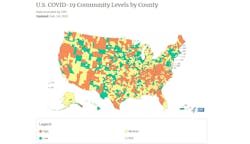CDC updates indoor mask mandates
Dr. Rochelle Walensky, Centers for Disease Control and Prevention (CDC) director, announced on Friday, February 25, 2022 that they are releasing new Centers for Disease Control and Prevention (CDC) recommendations on preventive indoor masking measures. The recommendation will allow approximately 70% of Americans to remove their masks indoors.
The new recommendations will depend on the COVID 19 level in the community. The COVID-19 community level is determined by the higher of the new admissions and inpatient beds metrics, based on the current level of new cases per 100,000 population in the past 7 days. Using these data, the COVID-19 community level is classified as low, medium, or high.
This updated approach focuses on directing prevention efforts towards protecting people at high risk for severe illness and preventing hospitals and healthcare systems from being overwhelmed.
With current high levels of vaccination and high levels of population immunity from both vaccination and infections, the risk of medically significant disease, hospitalization, and death from COVID-19 is greatly reduced for most people.
CDC is updating its framework to monitor the level of COVID 19 and communities. We’re in a stronger place today as a nation with more tools to protect ourselves in our communities from COVID 19, like vaccination, boosters, broader access to testing, availability of high quality masks, accessibility to new treatments, and improved ventilation. Over 200 million people have received a primary vaccine series and nearly 100 million have been boosted and millions more have had prior disease.
With widespread population immunity, the overall risk of severe disease is now generally lower. Now, as the virus continues to circulate in our communities, we must focus our metrics beyond just cases in the community and direct our efforts toward protecting people at high risk for severe illness and preventing COVID 19 from overwhelming our hospitals and our healthcare systems.
This new framework moves beyond just looking at cases and test positivity to evaluate factors that reflect the severity of disease, including hospitalizations and hospital capacity, and helps to determine whether the level of COVID 19 and severe disease are low, medium, or high in a community.
At the same time, we know that some people and communities, such as our oldest citizens, people who are immunocompromised, and people with disabilities, are at higher risk for serious illness and face challenging decisions navigating a world with COVID-19.
In addition to protecting those at highest risk of severe outcomes, focusing on reducing medically significant illness and minimizing strain on the healthcare system reflects our current understanding of SARS-CoV-2 infection, immunity from vaccination and infection, and the tools we have available.
Health officials and individuals should consider current information about COVID-19 hospitalizations in the community, as well as the potential for strain on the local health system and COVID-19 cases in the community, when making decisions about community prevention strategies and individual behaviors.
Communities and individuals should also make decisions based on whether they are at high risk for severe disease and take into account inequities in access to prevention strategies.
COVID-19 Community Levels can help communities and individuals make decisions based on their local context and their unique needs. Community vaccination coverage and other local information, like early alerts from surveillance, such as through wastewater or the number of emergency department visits for COVID-19, when available, can also inform decision making for health officials and individuals.
CDC looks at the combination of three metrics — new COVID-19 admissions per 100,000 population in the past 7 days, the percent of staffed inpatient beds occupied by COVID-19 patients, and total new COVID-19 cases per 100,000 population in the past 7 days — to determine the COVID-19 community level.
New COVID-19 admissions and the percent of staffed inpatient beds occupied represent the current potential for strain on the health system. Data on new cases acts as an early warning indicator of potential increases in health system strain in the event of a COVID-19 surge.
Layered prevention strategies — like staying up to date on vaccines, screening testing, ventilation and wearing masks — can help limit severe disease and reduce the potential for strain on the healthcare system. CDC recommends using county COVID-19 Community Levels to help determine which COVID-19 prevention measures to use for individuals and communities.
Some community settings such as schools and some high-risk congregate settings such as correctional facilities and homeless shelters might include additional layers of prevention (e.g., physical distancing, contact tracing) based on information and data about the characteristics of the setting. High-risk congregate settings may implement added prevention as needed in the event of a facility outbreak even if COVID-19 Community Levels in the surrounding community are low.
Jurisdictions should monitor health equity in vaccine and other prevention efforts and assess hospitalization data where possible to ensure outreach occurs to address any disparities in access to high quality healthcare.
Recommendations based on COVID-19 Community Levels may not apply to healthcare settings such as hospitals or long-term care facilities.
